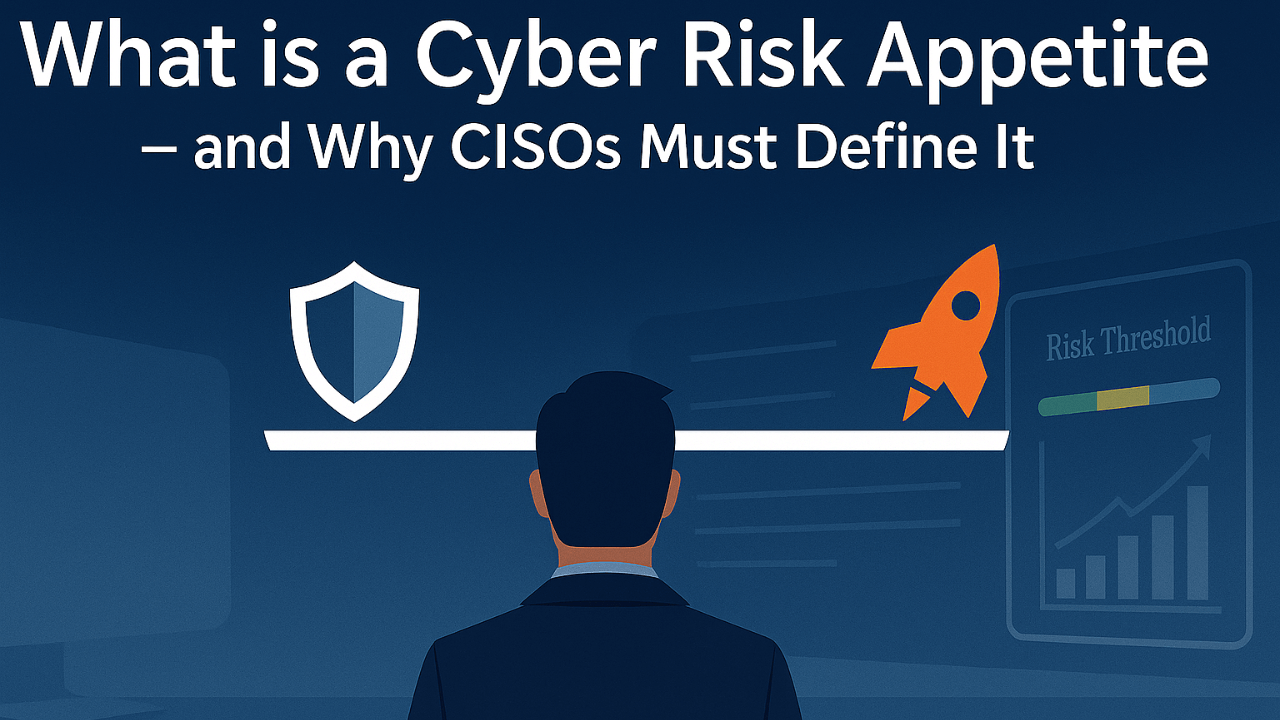For years, security teams have operated in a fog: chasing vulnerabilities, patching urgently, and justifying spend through fear-based narratives. But that’s changing. Mature organizations are asking a sharper question:
“What level of cyber risk are we actually willing to tolerate?”
This is the essence of Cyber Risk Appetite — the foundation of strategic cyber risk management.
Defining Cyber Risk Appetite
Cyber Risk Appetite is the amount and type of cyber risk an organization is prepared to accept in pursuit of its business objectives. It is not a technical metric — it’s a business decision, shaped by factors like industry exposure, regulatory obligations, digital ambitions, and stakeholder expectations.
Think of it as a compass. Without it, cyber programs drift. With it, CISOs can align controls, investments, and responses to a clear strategic threshold.
How to Establish a Risk Appetite (and Make It Actionable)
- Engage the Business — Make Risk a Shared Language
Start with facilitated workshops that bring together leadership across security, finance, operations, legal, and enterprise risk. The goal isn’t to define controls — it’s to ask:
- What types of cyber events would materially disrupt our business model?
- What trade-offs are we willing to accept to move fast or stay competitive?
- Where are we risk-averse vs. risk-tolerant, and why?
Walk through realistic threat scenarios — ransomware, insider fraud, third-party breaches — to reveal hidden assumptions and competing priorities. This creates cross-functional clarity and ensures risk appetite reflects business strategy, not just security orthodoxy.
- Translate to Impact Thresholds — Quantify What “Too Much” Means
Cyber risk appetite must be grounded in impact thresholds that define unacceptable loss. Examples include:
- “No single cyber event should expose us to more than $2M in expected financial loss.”
- “We will not tolerate >0.5% annual probability of outage to core platforms.”
- “Reputational damage from data loss must remain below high-sensitivity media thresholds.”
Leverage risk frameworks like NIST CSF, ISO 27005, or COSO ERM to define and structure these thresholds credibly.
- Link to Cyber Risk Quantification — Turn Philosophy Into Math
Risk appetite must be quantifiable to inform decisions. Use CRQ models to:
- Benchmark current exposure against defined limits
- Simulate high-impact scenarios (e.g., third-party breach of SaaS vendor)
- Prioritize budget and resource allocation where appetite is breached
This is how you shift from “Are we secure?” to “Are we operating within our defined cyber risk appetite?”
- Embed in Governance — Make It Operational, Not Aspirational
An effective risk appetite isn’t a one-off memo — it must shape everyday decisions:
- Prioritize controls where risk exceeds appetite
- Set clear thresholds for incident escalation
- Adjust third-party risk tiers based on potential business impact
- Report regularly to the board with risk exposure vs. appetite dashboards
Over time, this makes cyber risk appetite a living instrument — guiding strategic alignment, not just compliance.
Why It’s Hard: The Hidden Challenges CISOs Face
While the logic is clear, defining a cyber risk appetite is rarely straightforward in practice. Common roadblocks include:
- Vague executive expectations
Many business leaders want “low risk” but resist specifying acceptable thresholds — leaving CISOs to operate in ambiguity.
- Fear of quantifying the unacceptable
Putting numbers on potential loss invites scrutiny. Security leaders often fear that acknowledging risk tolerance will be seen as negligence.
- Disconnect between cyber and financial language
Security teams talk in CVEs and patch rates; boards care about EBITDA and materiality. This translation gap stalls appetite discussions.
- Overreliance on heatmaps and static risk registers
Without quantification, appetite becomes subjective — too abstract to guide decisions or justify budget.
The result? A lot of talk about “risk tolerance” with little operational traction. Overcoming these barriers requires more than frameworks — it demands cross-functional leadership, financial fluency, and cultural alignment.
Why It Matters
Gartner predicts that by 2026, 50% of boards will have dedicated cybersecurity oversight. Boardrooms are no longer asking if threats are real — they’re asking if you’ve defined what’s acceptable.
Without a clearly articulated cyber risk appetite:
- Cybersecurity becomes reactive, unfocused, and budget-challenged
- Risk discussions stay stuck in technical silos
- Leadership struggles to connect cyber threats to business risk
With it, security leaders can align teams, funding, and action around a shared definition of what matters most.
Final Thought
You don’t need to eliminate every risk.
But you do need to know — and prove — which risks you’re willing to take.
That’s not just smart cyber leadership. That’s business leadership.

